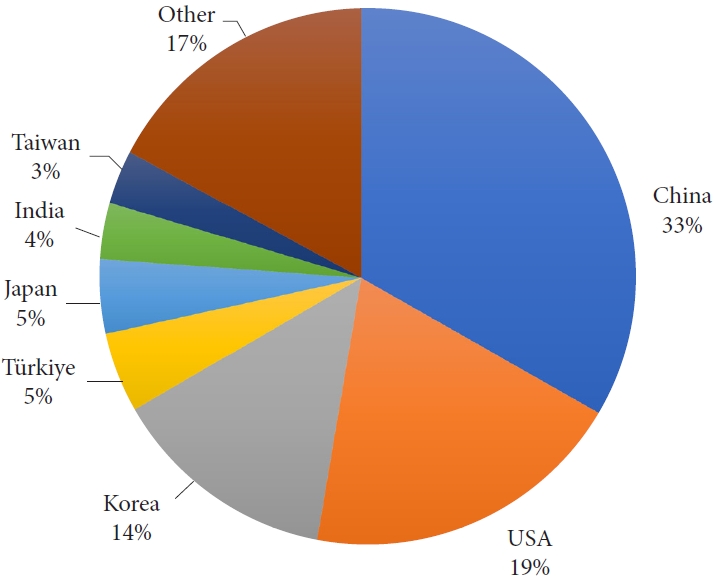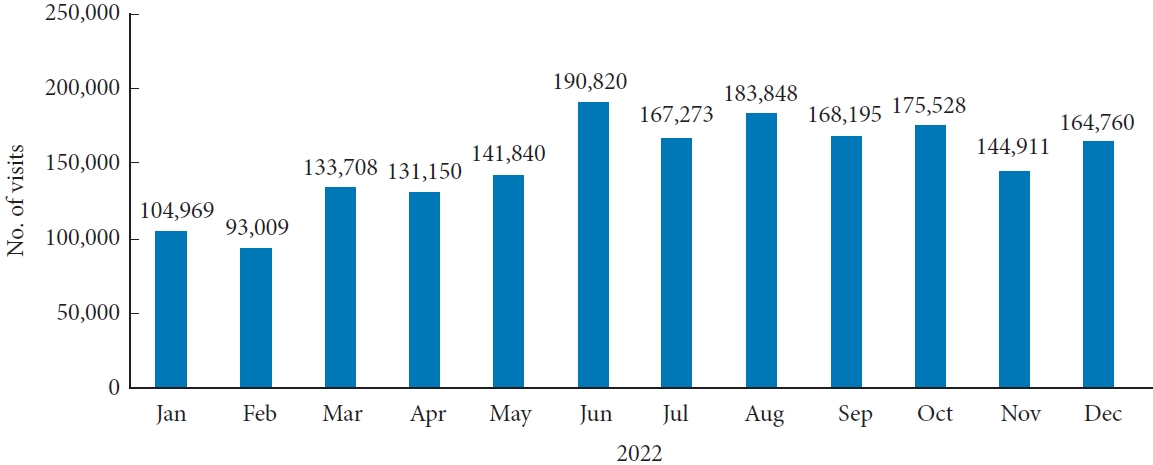Looking Back on 2022 With Neurospine
Article information
Abstract
On behalf of the editorial office of Neurospine, we would like to extend our appreciation to all the readers who have supported the journal throughout the year. Neurospine was established in March 2018 through a collaboration of 3 leading spinal neurosurgery societies from Japan, Korea, and Taiwan. Since then, Neurospine has continued to enhance its academic impact, serving as a platform for sharing knowledge and information related to the management of spinal diseases. In this article, we aim to present the bibliometrics of Neurospine, including the submission and publication of manuscripts and the peer review process. We are looking forward to continued growth and serving the academic community to the best of our ability.
INTRODUCTION
It has been another great year for Neurospine. We extend our heartfelt gratitude to all those who have contributed to its growth and development. We acknowledge the crucial role played by the editorial board, reviewers, staff, and readers, who have enabled us to serve as a platform for sharing knowledge and information related to spinal disease management. With all your help, the peer-reviewed articles published in Neurospine have provided a valuable resource for spine clinicians and researchers. As we reflect on Neurospine’s progress in 2022, we are reminded of the progress we have made and the opportunities that lie ahead for future growth.
HISTORY OF NEUROSPINE
Neurospine is an international, peer-reviewed, open-access journal that is published quarterly on the last day of March, June, September, and December. It was first established on March 31, 2004 under the name Korean Journal of Spine, and underwent a transformation in 2017 with the collaboration of 3 leading spinal neurosurgery societies from Japan, Korea, and Taiwan, during Asia Spine. Professor Ha Yoon was appointed as the editorin-chief with the goal of establishing Neurospine as an international journal. He was supported by deputy editors Shih-Huang Tai and Makoto Taniguchi, Associate Editor Seung-Jae Hyun, and 32 editorial board members from around the world. An advisory board was also established, comprising leading journal editors, world spine society leaders, leaders of the 3 societies (Japan, Taiwan, and Korea), and former editors of the Korean Journal of Spine. The first issue of Neurospine was published in March 2018 and, as of the end of 2021, the journal had received 1,495 submissions and published 431 documents. Neurospine is indexed/tracked/covered by a number of databases, including Science Citation Index Expanded, PubMed, PubMed Central, Scopus, Directory of Open Access Journals, KoreaMed, KoMCI, EBSCO host, and Google Scholar. The annual Neurospine symposium, which was temporarily suspended due to coronavirus disease 2019, has resumed with the aim of strengthening the capabilities of the editorial board and reviewers, and discussing the development of an efficient review system.
EDITORIAL DECISIONS
In 2022, a total of 545 papers were submitted to Neurospine. The submitted papers were analyzed by country, and the top 5 countries in order of submissions were China, the United States, Korea, Türkiye, and Japan (Fig. 1). As of the time of writing, 523 of the submissions have received a decision, with the remaining 22 still in processing. The submitted papers were initially evaluated by the editorial board, led by the editor-in-chief, and 64.4% (351 papers) were ultimately rejected. The remaining 35.6% (194 papers) were deemed to have relatively high academic value and underwent an additional peer review process. The editor-in-chief analyzed each paper and selected the appropriate editor, considering the unique characteristics of each submitted paper. The selected editor then chose peer reviewers from a specialty-based review board, taking care to avoid any conflicts of interest. Reviewers were sent an email containing the abstract of the paper in a blinded format and had up to 7 days to decide whether to accept the review.
REVIEWER INVITATION
A total of 801 review invitations were sent, and 546 (68.2%) were accepted. Of those, 70 invitations (8.7%) were declined, and 185 invitations (23.1%) did not receive a response. The acceptance rates varied by country, and the top 5 countries in order of acceptance rates were Korea, China, Japan, India, and Taiwan. On average, it took reviewers 5.5 days to accept review requests. Excluding former and current editors-in-chief and associate editors, the 3 editors who did the most editorial work in 2022 were Jae Keun Oh, Junseok Bae, and Dong Wuk Sohn, who were responsible for 21, 16, and 13 papers, respectively. Reviewers were given a maximum review period of 14 days after accepting a review request. Out of the 546 accepted invitations, 330 reviews (60.4%) were submitted on time and 173 (31.7%) were late. In 43 accepted reviews (7.9%), no results have been received yet. Three reviewers (Chi Heon Kim, Ikchan Jeon, and Su Hun Lee) were the most active in their respective roles. The average review period was 13.5 days.
PEER REVIEW AND PUBLICATION
At the time of this writing, 191 first reviews were finalized in 2022. Of these, 24 papers (12.6%) were accepted, 100 papers (52.4%) were recommended revision, and 67 papers (35.1%) were rejected. The average time from submission to the first decision was 45.4 days. Ninety-one papers underwent a second review, with 67 (73.6%) being accepted, 20 (22%) undergoing revision, and 4 (4.4%) being rejected. The average time from submission to the second decision was 85.5 days. Out of 15 third or further reviews, 14 (93.3%) were accepted, and 1 (6.7%) was rejected. The average time from submission to the final decision was 103.5 days. The average time from acceptance to publication was 71.2 days, and from submission to publication was 161.1 days (Fig. 2).
Neurospine published 123 articles in its quarterly issues in 2022. When classified by category, the published articles consisted of 72 original articles, 25 review articles, 1 technical note, 1 case report, and 21 editorials and letters.
HOMEPAGE OF NEUROSPINE
Neurospine can be accessed through its homepage at https://www.e-neurospine.org. On the homepage, visitors can find information on newly published articles, announcements of special issues, and access a bibliography of Neurospine papers that can be freely searched and downloaded. All papers published in Neurospine are open-access and free of article processing charges. The total number of visits to the site in 2022 was 1,800,011, with an average of 4,931.5 visits per day. The numbers of monthly visits are shown in Fig. 3. In 2022, the paper with the highest number of views was “Superior and Middle Cluneal Nerve Entrapment as a Cause of Low Back Pain” by Isu et al. [1] (Table 1). A total of 33,610 articles were downloaded in 2022, with “Pearls and Pitfalls of Oblique Lateral Interbody Fusion: A Comprehensive Narrative Review” by Kim et al. [2] being the most downloaded paper (Table 2).
CITATION REPORTS
According to the Journal Citation Reports by Clarivate Analytics, the 2021 Impact Factor of Neurospine was 3.374, a slight decrease from 3.492 in 2020 [3]. Unlike the Impact Factor, which does not include the current year, CiteScore, based on Scopus database by Elsevier, includes the results of the 4 years from 2018 to 2021. Neurospine published 316 documents, were cited by 1,334 documents, and recorded a 2021 CiteScore of 4.2, showing a sharp increase compared to the previous years (Fig. 4). This corresponds to the ranks of #82/469 and #147/359 in the categories of “Surgery” and “Neurology (clinical),” respectively. Compared to the ranks of #150/422 and #202/343 in the last year, the journal advanced by 68 and 55 ranks, respectively [4].
The SCImago Journal Rank, which reflects the scientific influence of an average article in the journal, also increased steadily from 0.923 in 2019 to 1.107 in 2021 (Fig. 5) [5]. A comparison between documents that have been cited at least once versus those not cited is shown in Fig. 6. Both groups have been increasing continuously in the most recent 3 years. The percentage of cited documents has remained stable, at approximately 60%, for the past 2 years. The proportion of self-cites relative to total cites is demonstrated in Fig. 7. While total cities showed persistent growth over the past three years, the number of self-citations has remained under 70. The self-citation rate was 8.45% in 2021.
CURRENT PROBLEMS AND FUTURE DIRECTION OF NEUROSPINE
In order to enhance its academic impact, Neurospine needs to consider increasing the frequency of publication. While other spine journals with similar impact factors publish between 12 and 24 issues annually, Neurospine publishes only quarterly issues, which may limit its reach. However, because expanding the publication frequency would require significant investments in financial and human resources, full support with the consensus of related societies would be necessary.
To streamline the submission and review process, Neurospine currently operates an online access system. However, the submission and review process still present certain challenges, which might be due to an inconvenient and outdated system. To address this, we plan to develop and distribute a unified template for article submissions in order to simplify the formatting process for authors. Additionally, the review system will continue to be improved to make the process more convenient for international authors and reviewers.
The rise and fall of academic journals depend heavily on the quality of the reviewers and editorial board members, as they play a crucial role in selecting high-quality papers that contribute to the advancement of the field. To attract competent and young reviewers and editorial board members from abroad, Neurospine will need to find effective ways to compensate those who contribute to the journal. This will be a crucial challenge for Neurospine to continue its growth.
CONCLUSION
We would like to extend our appreciation to all the readers who have supported Neurospine throughout the year. Your continued engagement and interest in the journal are critical to its success. We are committed to delivering the highest-quality content and providing a platform for the exchange of ideas in the field of Neurospine. We look forward to continued growth and progress in the coming years and to serving the academic community in the best way possible.
Notes
Conflict of Interest
The authors have nothing to disclose.
Funding/Support
This study received no specific grant from any funding agency in the public, commercial, or not-for-profit sectors.
Author Contribution
Conceptualization: DSR; Writing - original draft: DSR; Writing - review & editing: IBH.









